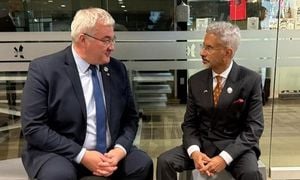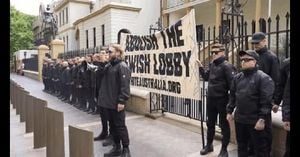On September 18, 2025, the Pentagon rolled out sweeping new restrictions on journalists covering the U.S. Department of Defense, marking a dramatic shift in how the media can report on military affairs from inside the nation’s most closely guarded building. The new rules, detailed in a memo distributed to news organizations and reported widely on September 19 and 20, require reporters to sign a pledge not to publish any information that has not been formally authorized by the administration. Even unclassified information must be cleared by an appropriate official before it can be made public.
This move is part of a broader effort by the Trump administration to clamp down on leaks and exert tighter control over the narrative emerging from the Pentagon. According to Nexstar Media Inc., the 17-page document warns: “Failure to abide by these rules may result in suspension or revocation of your building pass and loss of access.” The Pentagon argues that these measures are necessary to prevent the unauthorized disclosure of classified and controlled unclassified information, which it says could jeopardize national security and endanger Defense Department personnel.
But the new restrictions don’t stop at information control. The Pentagon has also sharply limited the physical movement of reporters within the building. Most areas now require journalists to be escorted by authorized personnel, with unescorted access allowed only in narrowly defined zones—primarily certain corridors on the first and second floors, the food court, and the central courtyard. Access to the 3rd, 4th, and 5th floors, the basement, and the mezzanine is strictly off-limits without an escort. These measures, effective immediately as of September 18, 2025, formalize and expand upon directives first announced in May of the same year.
In a statement released on Friday, Pentagon spokesman Sean Parnell defended the new guidelines, saying, “These are basic, common-sense guidelines to protect sensitive information as well as the protection of national security and the safety of all who work at the Pentagon.” He further noted that the guidelines are “in line with every other military base in the country.”
Reporters are now required to read and sign a detailed in-brief form as a condition of receiving their Pentagon Facility Alternate Credential (PFAC)—the building pass that grants them access. The form outlines information security requirements, physical control measures, and the expectations for compliance. The new PFACs, which will be issued to resident media through September 30, 2025, are emblazoned with the word “PRESS” in bright red letters to ensure easy identification. Alongside the PFAC, journalists must also display an Additional Press Identifier Badge at all times while inside the Pentagon.
Security protocols have also been beefed up. All individuals entering the building are subject to random metal detector and X-ray inspections, and their belongings may be checked when exiting. Reporters must be vigilant for suspicious activity and immediately report anything unusual to the Pentagon Force Protection Agency. Visual or audio recording—whether with professional cameras or cell phones—is strictly prohibited unless explicitly approved in advance, and even then, only in limited circumstances such as official press events or stand-ups in designated areas.
The memo, authored by Pentagon spokesman Sean Parnell, makes it clear that these changes are not merely suggestions. “Unauthorized disclosure of CNSI [classified national security information] or CUI [controlled unclassified information] poses a security risk that could damage the national security of the United States and place DoW personnel in jeopardy,” it reads. The document also spells out the consequences for non-compliance: “Failure to abide by these rules may result in suspension or revocation of your building pass and loss of access.”
Journalists who lose their credentials due to unauthorized access, attempted unauthorized access, or unauthorized disclosure of sensitive information will not only be barred from the Pentagon but will also have to follow a formal appeals process if they wish to contest the decision. The process, detailed in Appendix A of the in-brief, allows for written and oral responses, but the final decision rests with the Director of the Pentagon Force Protection Agency.
The new restrictions have drawn sharp criticism from press freedom advocates and journalists’ organizations. The National Press Club (NPC) was quick to denounce the move, calling it “a direct assault on independent journalism at the very place where independent scrutiny matters most: the U.S. military.” NPC President Mike Balsamo stated, “Independent reporting on the military is essential to democracy. It is what allows citizens to hold leaders accountable and ensures that decisions of war and peace are made in the light of day. This pledge undermines that principle, and the National Press Club calls on the Pentagon to rescind it immediately.”
Echoing this concern, Balsamo added, “If the news about our military must first be approved by the government, then the public is no longer getting independent reporting. It is getting only what officials want them to see. That should alarm every American.” The Pentagon Press Association Board also acknowledged the new directive and said it was reviewing its implications for press freedom and access.
The impact of these changes has already been felt in the makeup of the Pentagon press corps. Earlier in 2025, several established news organizations—including The New York Times, NPR, Politico, and NBC News—were removed from their Pentagon workspaces. According to Nexstar Media Inc., these were replaced by outlets whose coverage is viewed as more favorable by the current administration, such as The New York Post, Breitbart News, HuffPost, and One America News Network. This reshuffling has raised additional questions about the Pentagon’s commitment to transparency and the diversity of viewpoints represented in its press pool.
Secretary of Defense Pete Hegseth, who has overseen the implementation of these measures, has been unapologetic. “The ‘press’ does not run the Pentagon — the people do,” Hegseth declared on social platform X. “The press is no longer allowed to roam the halls of a secure facility. Wear a badge and follow the rules — or go home.”
For many journalists, the new rules represent a fundamental shift in the relationship between the military and the press. Compliance means that reporters will be unable to use unnamed U.S. military sources in much of their reporting without risking their access to the Pentagon—a move that critics argue could chill investigative journalism and limit the public’s understanding of military operations and policy decisions.
The Pentagon, for its part, maintains that these steps are necessary to safeguard national security and align with standard practices at other military facilities. Still, the debate over the balance between security and transparency is far from settled. With the new rules now in full effect, the future of independent reporting from inside the Pentagon—and the public’s right to know—hangs in the balance.





